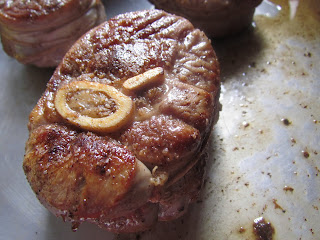There are people who have an affinity for a certain dish. Whenever they see the dish listed on a menu, they order it... but they usually leave slightly disappointed. It's never exactly what they expected.
However, it's probably not just the certain dish they have an affinity for. It's more a memory, an experience from the past. Maybe it's ambiance or the company shared.
Maybe it's just because it was 1986 and it happened to be a good year for one reason or another.
That little trattoria somewhere in Italy? That one cafe in Vienna?
You probably won't find here whatever memory was there.
Who knows? Were things really as they are remembered?
In different places you find different ingredients, too, or there are variations on an ingredient. That could be part of the problem.
The flour was ground a different way, the animals were fed other things, there's something about the climate, there's something in the water, the brandy was aged a little longer.
As far as osso buco goes, I'm aware veal shank isn't the cheapest cut of meat, and it's not the quickest meal to put together, so this dish is officially in the special occasion realm.
I don't know how it compares to memories... but memories are subjective.
Osso buco is great served with some perfectly creamy and al dente plain risotto.
Osso Buco
serves 8-10
10, 1 1/2-2 inch thick cuts of veal shank tightly tied around the perimeter, patted dry with paper
towels, and seasoned with salt and pepper
2 c chicken stock
1 c beef broth
1/2 oz dried porcini mushrooms
8 T vegetable oil, separated
2 1/2 c dry white wine, separated
2 c celery, diced
2 carrots, diced
1 large yellow onion, diced
3 T tomato paste
6 medium garlic cloves, minced
28 oz can good tomatoes in juice, roughly chopped
2 bay leaves
1 T fresh thyme, minced
1/3 c parsley
Zest of 2 lemons
3 medium garlic cloves, minced
Bring the chicken and beef broth to a boil with the porcini mushrooms. Turn off the heat, cover
the pan, and set aside for 20 minutes.
Remove the softened porcini mushrooms from the broth, chop them, and return to the pan with
the broth.
Preheat oven to 325 degrees F.
Heat 2 T oil in a large dutch oven (or heavy oven-proof pan) over medium-high heat. Sear the
meat until browned on both sides in batches without crowding the pan. Remove the seared meat
to a plate while you continue with the rest of the meat, adding extra oil as necessary. Once all of
the meat is seared deglaze the pan with 1/2 c of white wine. Scrape up all the browned bits from
the bottom of the pan. Repeat 2 more times, adding 1/2 c of wine and scraping the pan (the wine
will have reduced and become a bit syrupy at this point).
Reduce the heat to medium, pour 2 T oil in the pan, and add the carrots, celery, and onion.
Cook, stirring occasionally, until soft and browned. Add the tomato paste, stir and cook for a
few minutes until it becomes thicker and darker. Add the 6 minced garlic cloves and cook about
30 seconds, or until they become fragrant.
Increase the heat, add the hot broth, tomatoes and juice, bay leaves, thyme, and the remaining
wine. Nestle the seared meat into the sauce and add any meat juices to the pan. Bring the sauce
to a simmer, place a slightly cocked lid on the pan, and place the pan in the preheated oven.
Cook the osso buco for 2 hours, turning the meat ever 20 minutes.
Take the dutch oven out of the oven, place it on the stove, remove the meat to a plate to rest and cover with foil so it stays warm.
Bring the sauce to a boil and cook for about 15 minutes to reduce a bit. Taste and season as
necessary after reducing.
While the sauce boils make the gremolata. Chop the parsley and place in a bowl with the lemon
zest and minced garlic. Stir the mixture to combine and set aside until ready to use.
To serve, plate the meat, remove the strings, pour the reduced sauce over the top, and sprinkle with gremolata.

























































